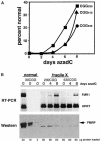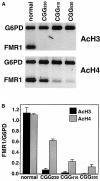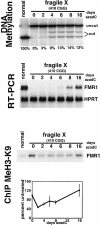Histone modifications depict an aberrantly heterochromatinized FMR1 gene in fragile x syndrome
- PMID: 12232854
- PMCID: PMC378545
- DOI: 10.1086/342931
Histone modifications depict an aberrantly heterochromatinized FMR1 gene in fragile x syndrome
Abstract
Fragile X syndrome is caused by an expansion of a polymorphic CGG triplet repeat that results in silencing of FMR1 expression. This expansion triggers methylation of FMR1's CpG island, hypoacetylation of associated histones, and chromatin condensation, all characteristics of a transcriptionally inactive gene. Here, we show that there is a graded spectrum of histone H4 acetylation that is proportional to CGG repeat length and that correlates with responsiveness of the gene to DNA demethylation but not with chromatin condensation. We also identify alterations in patient cells of two recently identified histone H3 modifications: methylation of histone H3 at lysine 4 and methylation of histone H3 at lysine 9, which are marks for euchromatin and heterochromatin, respectively. In fragile X cells, there is a decrease in methylation of histone H3 at lysine 4 with a large increase in methylation at lysine 9, a change that is consistent with the model of FMR1's switch from euchromatin to heterochromatin in the disease state. The high level of histone H3 methylation at lysine 9 may account for the failure of H3 to be acetylated after treatment of fragile X cells with inhibitors of histone deacetylases, a treatment that fully restores acetylation to histone H4. Using 5-aza-2'-deoxycytidine, we show that DNA methylation is tightly coupled to the histone modifications associated with euchromatin but not to the heterochromatic mark of methylation of histone H3 at lysine 9, consistent with recent findings that this histone modification may direct DNA methylation. Despite the drug-induced accumulation of mRNA in patient cells to 35% of the wild-type level, FMR1 protein remained undetectable. The identification of intermediates in the heterochromatinization of FMR1 has enabled us to begin to dissect the epigenetics of silencing of a disease-related gene in its natural chromosomal context.
Figures






Similar articles
-
Differential epigenetic modifications in the FMR1 gene of the fragile X syndrome after reactivating pharmacological treatments.Eur J Hum Genet. 2005 May;13(5):641-8. doi: 10.1038/sj.ejhg.5201393. Eur J Hum Genet. 2005. PMID: 15741991
-
Acetylated histones are associated with FMR1 in normal but not fragile X-syndrome cells.Nat Genet. 1999 May;22(1):98-101. doi: 10.1038/8807. Nat Genet. 1999. PMID: 10319871
-
The distribution of repressive histone modifications on silenced FMR1 alleles provides clues to the mechanism of gene silencing in fragile X syndrome.Hum Mol Genet. 2010 Dec 1;19(23):4634-42. doi: 10.1093/hmg/ddq394. Epub 2010 Sep 14. Hum Mol Genet. 2010. PMID: 20843831 Free PMC article.
-
Epigenetics, fragile X syndrome and transcriptional therapy.Am J Med Genet A. 2013 Nov;161A(11):2797-808. doi: 10.1002/ajmg.a.36264. Epub 2013 Oct 3. Am J Med Genet A. 2013. PMID: 24123753 Review.
-
[Chromatin changes caused by CGG repeat expansion in fmr1 gene].Mol Biol (Mosk). 2015 Mar-Apr;49(2):205-11. Mol Biol (Mosk). 2015. PMID: 26065250 Review. Russian.
Cited by
-
NF-Y, AP2, Nrf1 and Sp1 regulate the fragile X-related gene 2 (FXR2).Biochem J. 2006 Dec 1;400(2):327-35. doi: 10.1042/BJ20060734. Biochem J. 2006. PMID: 16886907 Free PMC article.
-
From FMRP function to potential therapies for fragile X syndrome.Neurochem Res. 2014 Jun;39(6):1016-31. doi: 10.1007/s11064-013-1229-3. Epub 2013 Dec 18. Neurochem Res. 2014. PMID: 24346713 Free PMC article. Review.
-
iPSC-derived forebrain neurons from FXS individuals show defects in initial neurite outgrowth.Stem Cells Dev. 2014 Aug 1;23(15):1777-87. doi: 10.1089/scd.2014.0030. Epub 2014 Apr 30. Stem Cells Dev. 2014. PMID: 24654675 Free PMC article.
-
Instability and chromatin structure of expanded trinucleotide repeats.Trends Genet. 2009 Jul;25(7):288-97. doi: 10.1016/j.tig.2009.04.007. Epub 2009 Jun 18. Trends Genet. 2009. PMID: 19540013 Free PMC article. Review.
-
Epigenetic Aberration of FMR1 Gene in Infertile Women with Diminished Ovarian Reserve.Cell J. 2018 Apr;20(1):78-83. doi: 10.22074/cellj.2018.4398. Epub 2017 Dec 1. Cell J. 2018. PMID: 29308622 Free PMC article.
References
Electronic-Database Information
-
- Online Mendelian Inheritance in Man (OMIM), http://www.ncbi.nlm.nih.gov/Omim/ (for FMR1 [MIM 309550]) - PubMed
References
-
- Bannister AJ, Zegerman P, Partridge JF, Miska EA, Thomas JO, Allshire RC, Kouzarides T (2001) Selective recognition of methylated lysine 9 on histone H3 by the HP1 chromodomain. Nature 410:120–124 - PubMed
-
- Bestor TH (1998) Methylation meets acetylation. Nature 393:311–312 - PubMed
-
- Boggs BA, Cheung P, Heard E, Spector DL, Chinault AC, Allis CD (2002) Differentially methylated forms of histone H3 show unique association patterns with inactive human X chromosomes. Nat Genet 30:73–76 - PubMed
-
- Chiurazzi P, Pomponi MG, Pietrobono R, Bakker CE, Neri G, Oostra BA (1999) Synergistic effect of histone hyperacetylation and DNA demethylation in the reactivation of the FMR1 gene. Hum Mol Genet 8:2317–2323 - PubMed
Publication types
MeSH terms
Substances
Associated data
- Actions
Grants and funding
LinkOut - more resources
Full Text Sources
Other Literature Sources
Medical
Molecular Biology Databases
Research Materials

